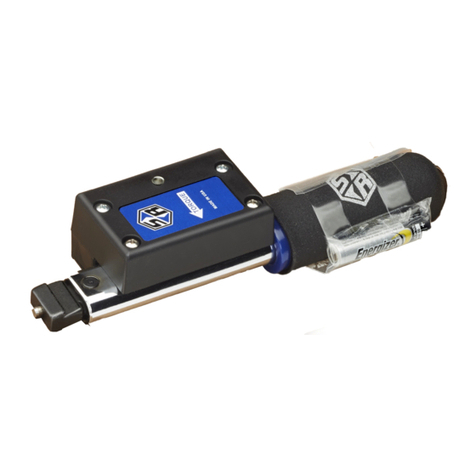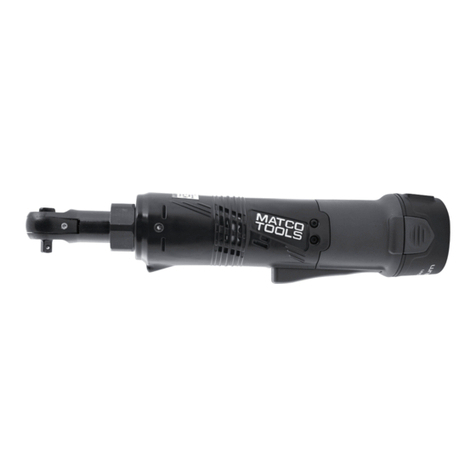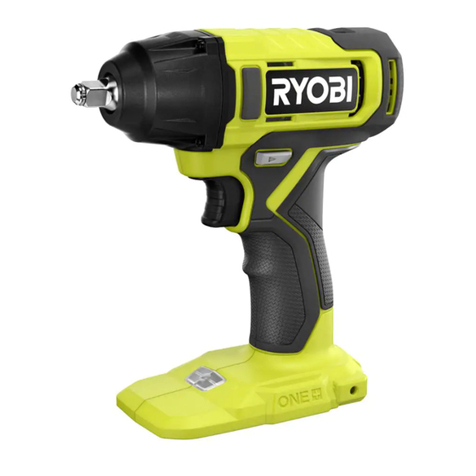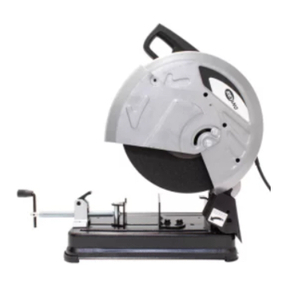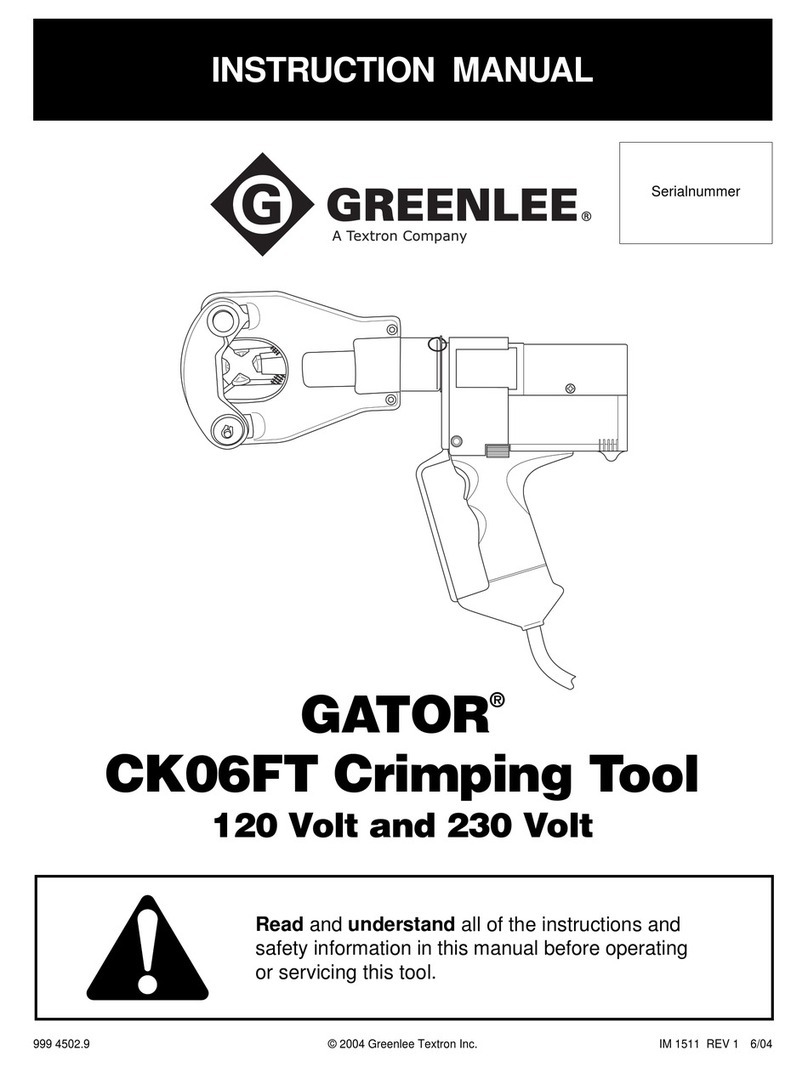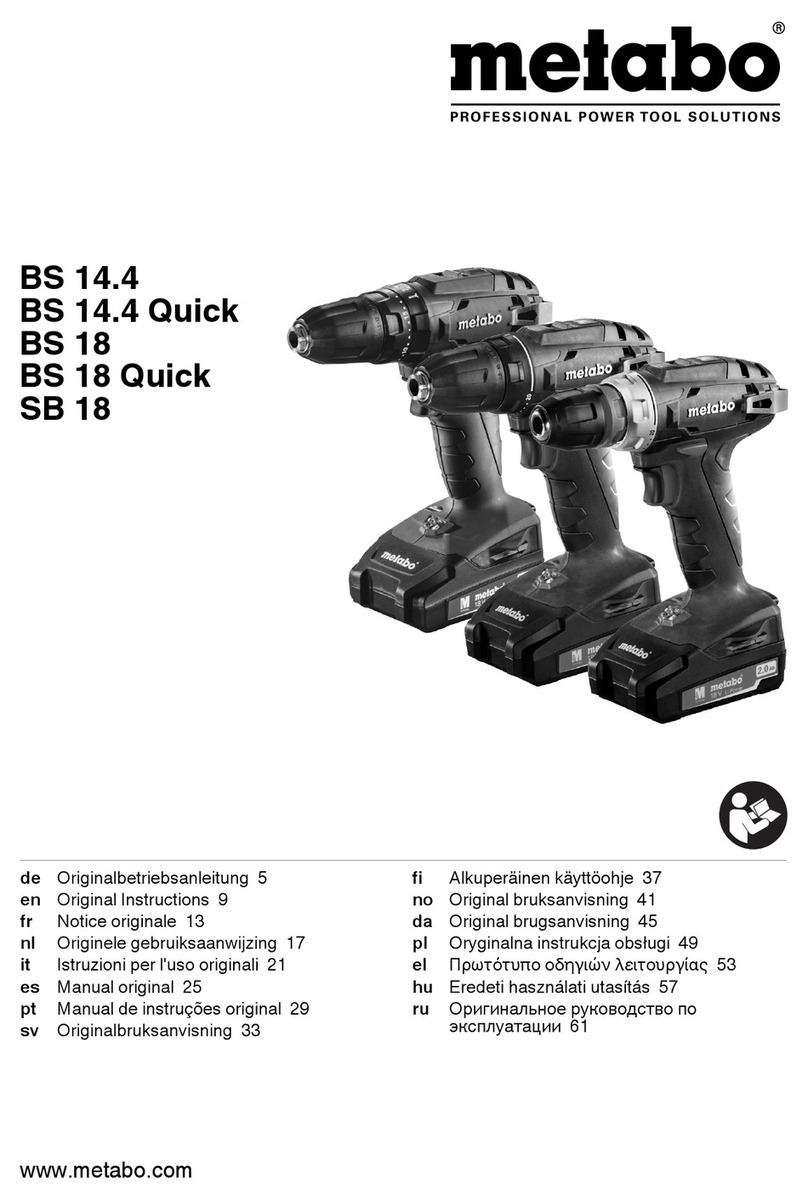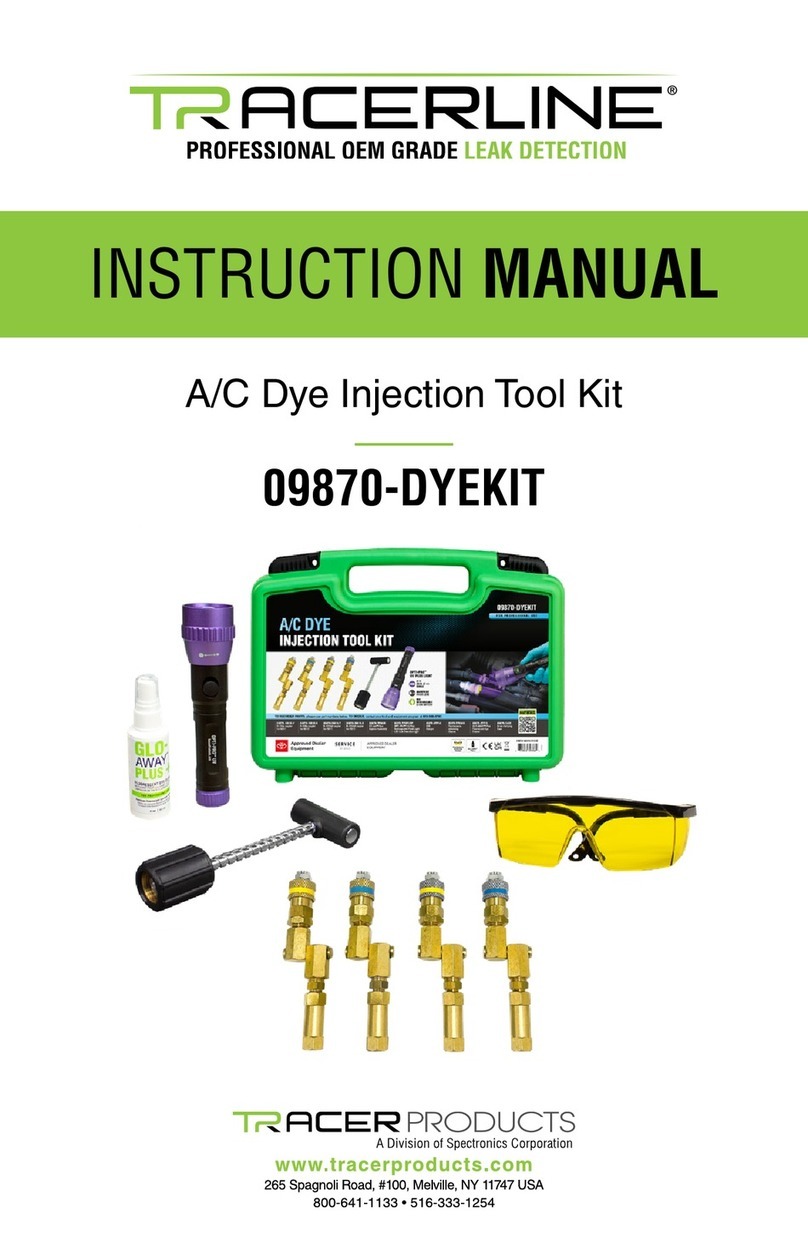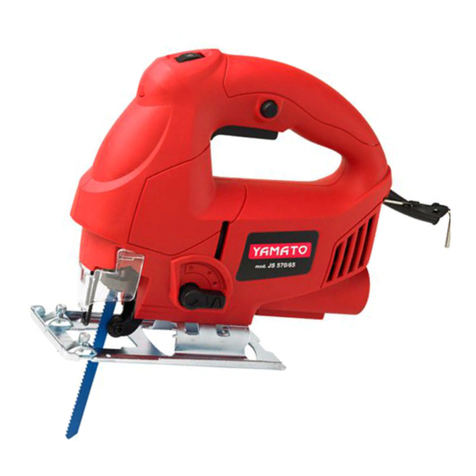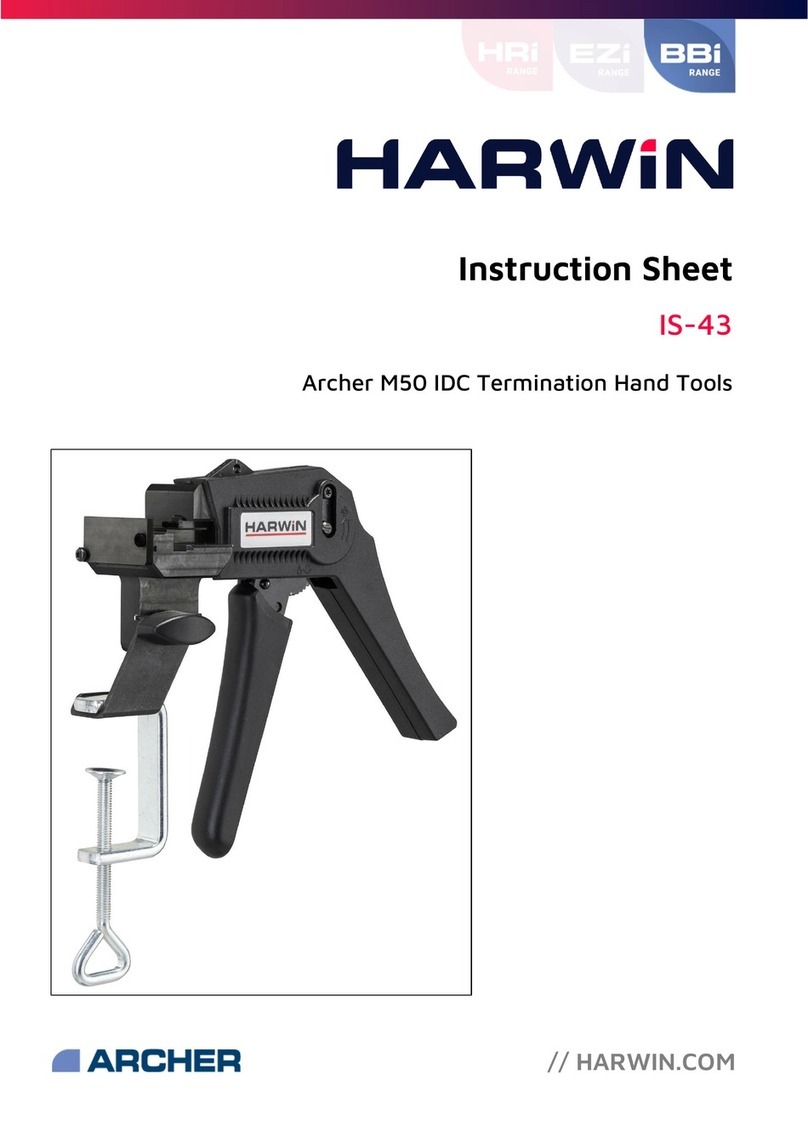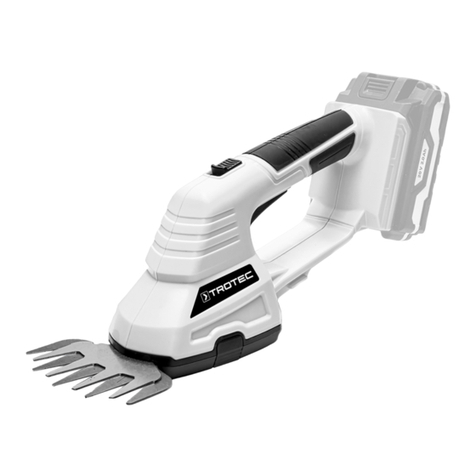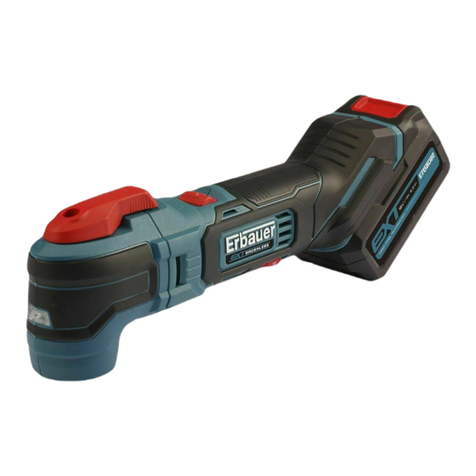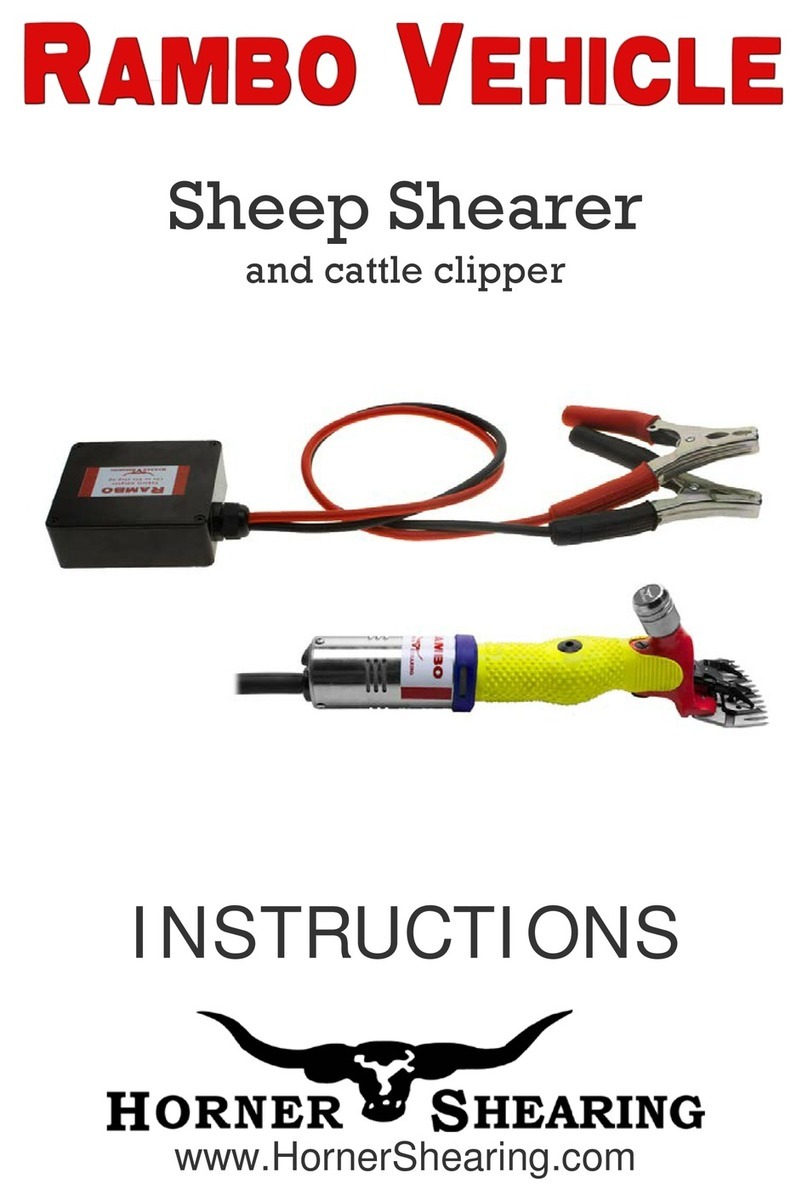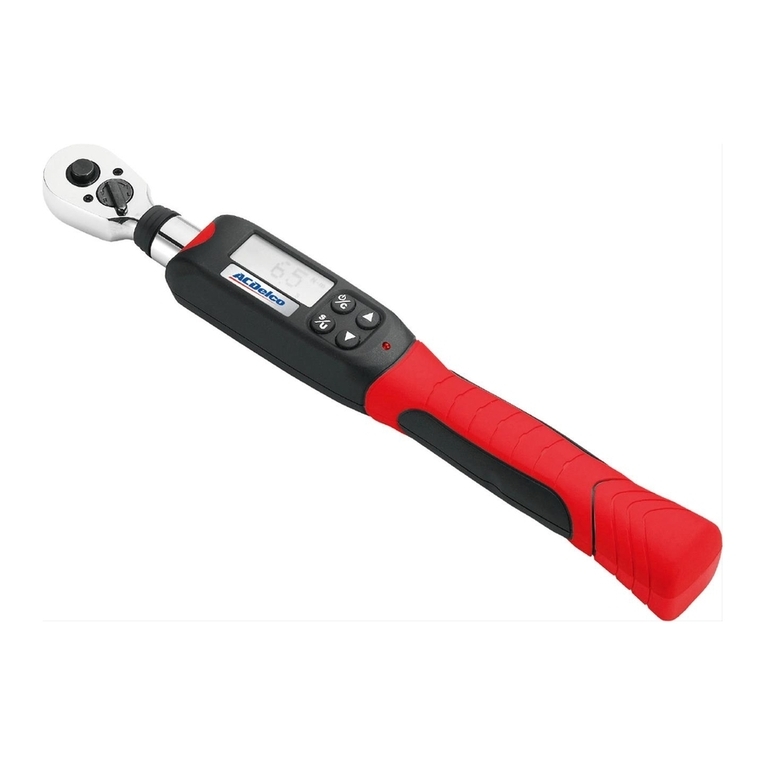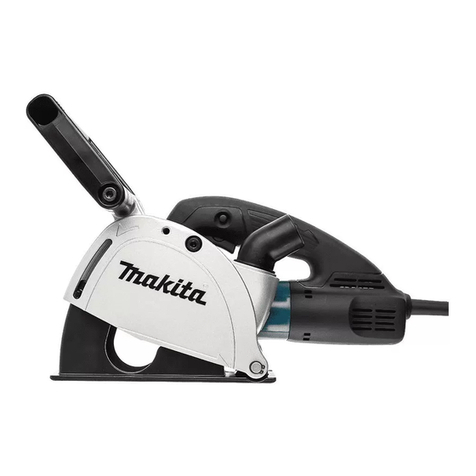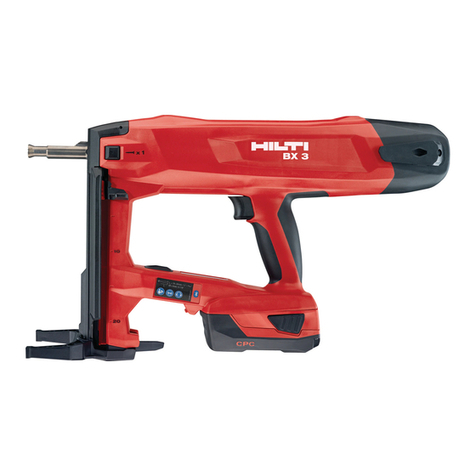PCC FTI ELB-15-10K Operating instructions

914074-Original, Log# 36767
FTI OPERATIONS, MAINTENANCE, AND REPAIR MANUAL
Electric Little Brute Puller Unit
FTI Part #2720-138, Log #36767
Revision Original
November 23rd, 2022
401 Andover Park East
Seattle, Washington 98188-7605
USA (206) 246-2010
Original Instruction

Fatigue Technology 401 Andover Park East Seattle, WA • USA 98188-2868 Tel: (206)246-2010 Fax: (206)244-9886
914074-Original
ABOUT FATIGUE TECHNOLOGY INC.
Fatigue Technology Inc. (FTI) is a world-leading aerospace engineering and manufacturing company. FTI pioneered
Cold Expansion (Cx™) technology (which provides solutions to fatigue problems associated with holes in metal
structures) back in 1969 and has advanced this science to develop innovative bushing and fastener products. These
proprietary products and associated tooling may be covered by patents or agreements owned by, or exclusively
licensed to, Fatigue Technology Inc. Use of tooling procured from other than a licensed source may constitute patent
infringement.
The detailed tooling information in this manual was compiled and written by FTI. The tooling was designed
specifically for use with FTI’s Cold Expansion systems. FTI cannot be held responsible for damage or injury as a
result of operating this equipment if it is used for other than the process intended, with any other tooling not provided
by FTI, or not used in accordance with the instructions contained in this manual. To avoid personal injury, please
observe all safety precautions and instructions. FTI reserves the right to change specifications or configurations of
equipment detailed in this manual as part of our ongoing technical and product improvement programs. If you have
any questions about the use or serviceability of this equipment, please contact our Sales Department.
FTI’s Cold Expansion systems and processes are the subject matter of one or more of the following patents: 4,809,420;
4,885,829; 4,934,170; 5,083,363; 5,096,349; 5,103,548; 5,127,254; 5,129,253; 5,218,854; 5,245,743; 5,305,627;
5,341,559; 5,380,136; 5,405,228; 5,433,100; 5,468,104; 6,077,010; 6,183,180; 6,487,767; 6,792,657; 6,990,722;
7,024,908; 1,061,276; 513,898; 692015124; 581,385; 69310828; 468,598; 69105390; 643,231; 69414946; 696,686;
785,366; 1032769; and other patents pending. These systems and processes are tooling critical and must be performed
in accordance with FTI’s specifications or controlling documents. To ensure proper results from FTI’s Cold
Expansion systems and to be licensed to use FTI’s patented processes, it is essential that FTI’s complete integrated
system of tooling be purchased and utilized. The use of tooling purchased from other than a licensed supplier could
jeopardize fatigue life enhancement and may constitute patent infringement.
Fatigue Technology Inc. (FTI) has provided innovative solutions to fatigue problems in metal structures since 1969.
Complete systems of tooling are used worldwide to enhance the fatigue life of holes in airframes, turbine engines,
and other critical structures.
The FTI staff of professionals provides a full range of support services including:
1. Application engineering
2. Detailed project planning, implementation, and management
3. On-site assistance, including training and tool room setup
The Sales Department is always available to assist with special fatigue enhancement requirements. Please contact
FTI with questions at any time.
This manual can be made available in other languages. Please contact the Sales Department to request a copy.

Fatigue Technology 401 Andover Park East Seattle, WA • USA 98188-7605 Tel: (206)246-2010 Fax: (206)244-9886
914074-Original
TABLE OF CONTENTS
SECTION DESCRIPTION PAGE
1.0 Introduction......................................................................................................................................... 1
1.1 About the Electric Little Brute Puller Unit.............................................................................. 1
1.2 General Description................................................................................................................. 1
1.3 General Specifications............................................................................................................. 2
2.0 Safety .................................................................................................................................................. 3
2.1 General Power Tool Safety Warnings ..................................................................................... 3
2.2 Electric Little Brute Safety Warnings ..................................................................................... 5
3.0 Puller Unit Operating Instructions ...................................................................................................... 6
3.1 Puller Unit Setup Procedure and Operation............................................................................. 6
3.2 Display and Menus.................................................................................................................. 7
3.3 Setting the Pressure Limit ..................................................................................................... 10
3.4 Activation of Puller Unit ....................................................................................................... 11
4.0 Puller Unit Maintenance ................................................................................................................... 12
4.1 General Cleaning................................................................................................................... 12
4.2 Preventative Maintenance ..................................................................................................... 12
4.3 Lubrication ............................................................................................................................ 12
4.4 Inspection .............................................................................................................................. 12
4.5 Air Tank................................................................................................................................. 13
4.6 Repair .................................................................................................................................... 13
5.0 Troubleshooting ................................................................................................................................ 14
6.0 Illustrated Parts Breakdown.............................................................................................................. 15
6.1 Electric Little Brute Parts List............................................................................................... 15
6.2 Electric Little Brute Assembly Diagram ............................................................................... 19
Appendix A Hydraulic Oil Safety Data Sheet....................................................................................................... 20
Appendix B E.C. and UKCA Declaration of Conformity..................................................................................... 27

Fatigue Technology 401 Andover Park East Seattle, WA • USA 98188-2868 Tel: (206)246-2010 Fax: (206)244-9886
914074-Original
TABLE OF CONTENTS (CONTINUED)
SECTION DESCRIPTION PAGE
FIGURES
Figure 1.3-1 Electric Little Brute Puller Unit Parts................................................................................................. 2
Figure 2.0-1 Safety Stickers .................................................................................................................................... 5
Figure 3.2-1 Main Menu.......................................................................................................................................... 7
Figure 3.2-2 Statistics Screen .................................................................................................................................. 7
Figure 3.2-3 Maintenance Screen............................................................................................................................ 8
Figure 3.2-4 Trigger Setting Screen ........................................................................................................................ 8
Figure 3.2-5 Trigger Setting Selection Screen......................................................................................................... 8
Figure 3.2-6 Double Click Trigger Setting.............................................................................................................. 9
Figure 3.2-7 Info Screen.......................................................................................................................................... 9
Figure 3.3-1 Pressure Limit Menu......................................................................................................................... 10
Figure 3.3-2 Pressure Limit Current Setting.......................................................................................................... 10
Figure 3.3-3 Pressure Limit New Setting .............................................................................................................. 10
Figure 3.4-1 Display During a Cycle..................................................................................................................... 11
Figure 4.5-1 Depressurizing Air Tank................................................................................................................... 13
Figure 6.2-1 Electric Little Brute Assembly.......................................................................................................... 19
TABLES
Table 1.3-1 Electric Little Brute Specifications..................................................................................................... 2
Table 3.4-1 Red Status LED Signals.................................................................................................................... 11
Table 6.1-1 ELB-15-10K Parts List ..................................................................................................................... 15
Table 6.1-2 ELB-20-10K Parts List ..................................................................................................................... 16
Table 6.1-3 ELB-30-10K Parts List ..................................................................................................................... 17
Table 6.1-4 Additional Parts List for ELB-xx-10K-120V and ELB-xx-10K-NBC ............................................. 18
.

Fatigue Technology 401 Andover Park East Seattle, WA • USA 98188-7605 Tel: (206)246-2010 Fax: (206)244-9886
914074-Original 1
SECTION 1.0: INTRODUCTION
This instruction manual contains information on the operation and maintenance of the Electric Little Brute (ELB)
Puller Unit. To obtain optimum performance and many years of trouble-free service, operate the puller unit properly
and carefully follow maintenance procedures.
Read this manual before operating the puller unit and retain it for future reference.
1.1 ABOUT THE ELECTRIC LITTLE BRUTE PULLER UNIT
The Electric Little Brute hydraulic puller unit is a powerful, compact, lightweight tool specifically designed for
use with Fatigue Technology Inc. (FTI) patented Split Sleeve Cold Expansion™ (SsCx™) process. The Electric
Little Brute Puller Unit is designed to pull a mandrel through a hole with the pre-lubricated stainless steel split
sleeves used in this process. The puller is also compatible with other FTI processes including ForceMate®
ForceTec®, GromEx®, etc.
The puller is designed with the same attachment threads as other FTI Little Brute pullers and is directly compatible
with most Little Brute tooling. The Electric Little Brute is intended for low-rate production and repair applications.
For high quantity continuous use, a standard air-powered Little Brute is preferred.
The Electric Little Brute puller has a maximum pull force of 10,000 pounds (44,482N). The tool is capable of
cold expanding holes up to 9/16 inches (14.3 mm) in diameter and 3 inches (76.2 mm) deep in aluminum, and
3/8 inches (9.53 mm) in diameter and 3 inches (76.2 mm) deep in steel and titanium. Larger diameters may be
evaluated on a case by case basis, contact FTI Sales for application assistance.
The Electric Little Brute is available in various models to accommodate multiple battery, charger, and mandrel
adapter options.
ELB-xx-10K-120V where ‘-xx’ relates to material stackup (see Table 1.3-1).
ELB-xx-10K-NBC where ‘-NBC’ represents that no battery or charger is included.
The Electric Little Brute has a fail-safe control system that causes the puller retraction cycle to be interrupted
whenever the operator releases finger pressure on the trigger or in the event of maximum pressure being reached.
The Electric Little Brute is very reliable and requires minimal maintenance.
The ELB-xx-10K features a digital display that can be used to display live pressure, peak pressure, and cycles
until recommended maintenance. It can also be used to set a pressure limit at a value below 10,000 PSI.
1.2 GENERAL DESCRIPTION
Operating Hydraulic Pressure....................... 10,000 psi (68.9MPa)
Pull Force Capacity....................................... 10,000 pounds (44,482N)
Hydraulic Fluid Requirements...................... FTI Part Number 1199-532
Operating Temperature................................. 14°F to 104°F (-10°C to 40°C)
Operating Voltage......................................... 18 Volts
Vibration....................................................... ah <2.5 m/s2
Noise ............................................................. LpA <70dB(A)
Battery Life................................................... Approximately 200-400 Cycles (depending on hole size)
Actuation....................................................... Electric
Operation ...................................................... Electric
Return ........................................................... Air
Battery........................................................... Makita BL1860B
Battery Charger............................................. Makita DC18RC

Fatigue Technology 401 Andover Park East Seattle, WA • USA 98188-2868 Tel: (206)246-2010 Fax: (206)244-9886
2914074-Original
Battery Level
Indicator
Status LED
Return Button
1.3 GENERAL SPECIFICATIONS
Nosecap Selection: The Electric Little Brute is compatible with both standard and flush nosecaps. See FTI’s
comprehensive Tooling Catalog for more information.
Mandrel Selection: The Electric Little Brute is directly compatible with standard Type 1, 7/16-20 threaded
mandrels. The ELB may also be adapted to tang or pintail mandrels using LB-CA and LB-PC chuck assemblies,
respectively. See FTI’s comprehensive Tooling Catalog for more information.
Figure 1.3-1 and Table 1.3-1 show the parts and specifications of the Electric Little Brute Puller Unit.
Figure 1.3-1
Electric Little Brute Puller Unit Parts
Table 1.3-1
Electric Little Brute Specifications
Model
Number
Maximum
Material
Stackup
(inch)
Length
(inch)
Pull Force
(lbs.)
Weight With
Battery
(lb.)
Stroke
(inch)
ELB-15-10K
1.5
(38.1 mm)
9.8
(248.9 mm)
10,000
6.9
(3.13 kg)
2.5
(63.5 mm)
ELB-20-10K
2.0
(50.8 mm)
10.8
(274.3 mm)
10,000
7.1
(3.22 kg)
3.0
(76.2 mm)
ELB-30-10K
3.0
(76.2 mm)
12.8
(325.1 mm)
10,000
7.5
(3.40 kg)
4.0
(101.6 mm)
Trigger
Work Light
Battery Release
Menu Buttons
Display
Air Fill Valve

Fatigue Technology 401 Andover Park East Seattle, WA • USA 98188-7605 Tel: (206)246-2010 Fax: (206)244-9886
914074-Original 3
SECTION 2.0: SAFETY
2.1 GENERAL POWER TOOL SAFETY WARNINGS
WARNING Read all safety warnings, instructions, illustrations, and specifications provided with this
power tool. Failure to follow all instructions listed below may result in electric shock, fire and/or serious injury.
Save all warnings and instructions for future reference.
The term "power tool" in the warnings refers to your mains-operated (corded) power tool or battery-operated
(cordless) power tool.
1) Work area safety
a) Keep work area clean and well lit. Cluttered or dark areas invite accidents.
b) Do not operate power tools in explosive atmospheres, such as in the presence of flammable
liquids, gases or dust. Power tools create sparks which may ignite the dust or fumes.
c) Keep children and bystanders away while operating a power tool. Distractions can cause you to lose
control.
2) Electrical safety
a) Power tool plugs must match the outlet. Never modify the plug in any way. Do not use any adapter
plugs with earthed (grounded) power tools. Unmodified plugs and matching outlets will reduce risk of
electric shock.
b) Avoid body contact with earthed or grounded surfaces, such as pipes, radiators, ranges and
refrigerators. There is an increased risk of electric shock if your body is earthed or grounded.
c) Do not expose power tools to rain or wet conditions. Water entering a power tool will increase the risk
of electric shock.
d) Do not abuse the cord. Never use the cord for carrying, pulling or unplugging the power tool. Keep
cord away from heat, oil, sharp edges or moving parts. Damaged or entangled cords increase the risk
of electric shock.
e) When operating a power tool outdoors, use an extension cord suitable for outdoor use. Use of a
cord suitable for outdoor use reduces the risk of electric shock.
f) If operating a power tool in a damp location is unavoidable, use a residual current device (RCD)
protected supply. Use of an RCD reduces the risk of electric shock.
3) Personal safety
a) Stay alert, watch what you are doing and use common sense when operating a power tool. Do not
use a power tool while you are tired or under the influence of drugs, alcohol or medication. A
moment of inattention while operating power tools may result in serious personal injury.
b) Use personal protective equipment. Always wear eye protection. Protective equipment such as a dust
mask, non-skid safety shoes, hard hat or hearing protection used for appropriate conditions will reduce
personal injuries.
c) Prevent unintentional starting. Ensure the switch is in the off-position before connecting to power
source and/or battery pack, picking up or carrying the tool. Carrying power tools with your finger on
the switch or energizing power tools that have the switch on invites accidents.
d) Remove any adjusting key or wrench before turning the power tool on. A wrench or a key left
attached to a rotating part of the power tool may result in personal injury.
e) Do not overreach. Keep proper footing and balance at all times. This enables better control of the
power tool in unexpected situations.
f) Dress properly. Do not wear loose clothing or jewelry. Keep your hair and clothing away from
moving parts. Loose clothes, jewelry or long hair can be caught in moving parts.
g) If devices are provided for the connection of dust extraction and collection facilities, ensure these
are connected and properly used. Use of dust collection can reduce dust-related hazards.
h) Do not let familiarity gained from frequent use of tools allow you to become complacent and ignore
tool safety principles. A careless action can cause severe injury within a fraction of a second.

Fatigue Technology 401 Andover Park East Seattle, WA • USA 98188-2868 Tel: (206)246-2010 Fax: (206)244-9886
4914074-Original
4) Power tool use and care
a) Do not force the power tool. Use the correct power tool for your application. The correct power tool
will do the job better and safer at the rate for which it was designed.
b) Do not use the power tool if the switch does not turn it on and off. Any power tool that cannot be
controlled with the switch is dangerous and must be repaired.
c) Disconnect the plug from the power source and/or remove the battery pack, if detachable, from
the power tool before making any adjustments, changing accessories, or storing power tools. Such
preventive safety measures reduce the risk of starting the power tool accidentally.
d) Store idle power tools out of the reach of children and do not allow persons unfamiliar with the
power tool or these instructions to operate the power tool. Power tools are dangerous in the hands
of untrained users.
e) Maintain power tools and accessories. Check for misalignment or binding of moving parts,
breakage of parts and any other condition that may affect the power tool’s operation. If damaged,
have the power tool repaired before use. Many accidents are caused by poorly maintained power tools.
f) Keep cutting tools sharp and clean. Properly maintained cutting tools with sharp cutting edges are less
likely to bind and are easier to control.
g) Use the power tool, accessories and tool bits etc. in accordance with these instructions, taking
into account the working conditions and the work to be performed. Use of the power tool for
operations different from those intended could result in a hazardous situation.
h) Keep handles and grasping surfaces dry, clean and free from oil and grease. Slippery handles and
grasping surfaces do not allow for safe handling and control of the tool in unexpected situations.
5) Battery tool use and care
a) Recharge only with the charger specified by the manufacturer. A charger that is suitable for one type
of battery pack may create a risk of fire when used with another battery pack.
b) Use power tools only with specifically designated battery packs. Use of any other battery packs may
create a risk of injury and fire.
c) When battery pack is not in use, keep it away from other metal objects, like paper clips, coins,
keys, nails, screws, or other small metal objects, that can make a connection from one terminal to
another. Shorting the battery terminals together may cause burns or a fire.
d) Under abusive conditions, liquid may be ejected from the battery; avoid contact. If contact
accidentally occurs, flush with water. If liquid contacts eyes, additionally seek medical help. Liquid
ejected from the battery may cause irritation or burns.
e) Do not use a battery pack or tool that is damaged or modified. Damaged or modified batteries may
exhibit unpredictable behavior resulting in fire, explosion or risk of injury.
f) Do not expose a battery pack or tool to fire or excessive temperature. Exposure to fire or temperature
above 130 °C may cause explosion.
g) Follow all charging instructions and do not charge the battery pack or tool outside the temperature
range specified in the instructions. Charging improperly or at temperatures outside the specified range
may damage the battery and increase the risk of fire.
6) Service
a) Have your power tool serviced by a qualified repair person using only identical replacement parts.
This will ensure that the safety of the power tool is maintained.
b) Never service damaged battery packs. Service of battery packs should only be performed by the
manufacturer or authorized service providers.

Fatigue Technology 401 Andover Park East Seattle, WA • USA 98188-7605 Tel: (206)246-2010 Fax: (206)244-9886
914074-Original 5
2.2 ELECTRIC LITTLE BRUTE SAFETY WARNINGS
Ultimately, operators are responsible for their own safety; however, the following general safety precautions
should be observed.
1. Operators must read this manual in its entirety before using the Electric Little Brute. Wear eye protection
when operating the puller unit. Hearing protection is not required for this puller unit. Do not strike any part
of the tool with a hammer or equivalent object. Keep hands and fingers clear of the nosecap, as they could be
crushed between the nosecap and the workpiece. Safety labels on the tool act as a reminder to these
instructions and are shown in Figure 2.0-1.
Read manual before using Always wear eye protection
Do not strike Keep fingers away from nosecap
Figure 2.0-1
Safety Labels
2. The puller unit is bundled with a Makita battery and charger (except for model numbers ending in -NBC).
This manual does not cover the use and safety precautions of these accessories. Refer to the Makita
documentation.
3. Disconnect the battery when:
- Maintenance is to be performed
- Tool is to be stored for an extended period
- Threading on mandrels, nosecaps, or other tooling
4. Do not use in potentially explosive atmospheres. Do not use in wet environments.
5. In the event of a ruptured or leaking hydraulic component, IMMEDIATELY RELEASE THE TRIGGER.
Never use your hands to grasp a leaking hydraulic component under pressure. The force of escaping
hydraulic fluid could cause serious injury. If hydraulic oil should penetrate the skin, medical attention must
be sought immediately.
6. Do not operate the puller or connect the battery while any component is disassembled, missing, or loose.
Injury may occur.
7. Only use FTI mandrels, nosecaps, and accessories with this puller. Some attachments may be at risk of
breakage if used at an inappropriate pressure setting. Be sure to follow all applicable FTI specifications,
accessory manuals, and tip sheets for the products being used. If a lower pressure is needed for the application,
refer to Section 3.3 for pressure setting.

Fatigue Technology 401 Andover Park East Seattle, WA • USA 98188-2868 Tel: (206)246-2010 Fax: (206)244-9886
6914074-Original
SECTION 3.0: PULLER UNIT OPERATING INSTRUCTIONS
Become familiar with these instructions before operating the puller. Retain the instructions for future reference.
3.1 Puller Unit Setup Procedure and Operation
Refer to Section 6 (Illustrated Parts Breakdown) for parts identification.
1. Inspect all threads and fittings for signs of wear or damage and replace them if necessary.
2. Ensure that the piston is in the fully forward position. If not, hold the return button down until the piston stops
moving.
3. Install the appropriate mandrel in the threaded adapter. The piston is locked while in the fully forward position,
so no tool is needed to keep it from rotating. Install the proper chuck assembly in place of the threaded adapter
if a tang or pintail mandrel is to be used.
4. Install the appropriate nosecap assembly over the mandrel and thread it into place.
5. Ensure that the battery is fully charged. If needed, charge the battery with the battery charger. This manual
does not cover the use and safety precautions of these accessories. Refer to the Makita documentation.
6. Check that the electrical contacts on the battery and tool are clean. Slide the battery onto the puller until it
clicks into place.

Fatigue Technology 401 Andover Park East Seattle, WA • USA 98188-7605 Tel: (206)246-2010 Fax: (206)244-9886
914074-Original 7
3.2 Display and Menus
1. Turn on the puller unit by quickly depressing the trigger on the handle and immediately releasing it. Do not
hold the trigger at this point unless you want the puller to retract (see section 3.4). Once the puller is turned
on, you will see the main screen below.
Figure 3.2-1
Main Menu
2. Pressing the right menu button will take you to the following screen showing the cumulative statistics of the
tool.
Figure 3.2-2
Statistics Screen
Live Pressure Reading
Peak Pressure
Battery Level
^
P
P
115 psi
4898 psi
TOTAL:
t
=
Q=
n
=
h
Ah
0.23
1.20
147
Operating Hours
Battery Capacity Used
Number of Cycles

Fatigue Technology 401 Andover Park East Seattle, WA • USA 98188-2868 Tel: (206)246-2010 Fax: (206)244-9886
8914074-Original
3. The next menu screen shows the number of cycles remaining before preventative maintenance is
recommended.
Figure 3.2-3
Maintenance Screen
4. The next menu screen shows the trigger click setting. The default behavior activates the puller with a single
pull of the trigger. If desired, the user can set the tool to require double-clicking instead to prevent accidental
activation.
Figure 3.2-4
Trigger Setting Screen
5. To change to double-click trigger behavior, press and hold both menu buttons for 3 seconds. The screen will
change to highlight the current setting.
Figure 3.2-5
Trigger Setting Selection Screen
NEXT SERVICE
9853 Ops
CURRENT USER: 1
Single Click
USER SELECT: 1
Single Click
Hold 3s
Hold 3s

Fatigue Technology 401 Andover Park East Seattle, WA • USA 98188-7605 Tel: (206)246-2010 Fax: (206)244-9886
914074-Original 9
6. Next, click the right menu button to select the double-click user profile. Confirm the selection by pressing and
releasing the trigger.
Figure 3.2-6
Double Click Trigger Setting
7. The next screen shows the currently installed firmware and the pump identification number.
Figure 3.2-7
Info Screen
USER SELECT: 2
Double Click
INFO
FW:
101026606NW001
2.4.7

Fatigue Technology 401 Andover Park East Seattle, WA • USA 98188-2868 Tel: (206)246-2010 Fax: (206)244-9886
10 914074-Original
3.3 Setting the Pressure Limit
1. By default, the puller will operate up to the maximum limit of 10,000 PSI. However, for some applications a
lower limit is desired. The tool immediately stops when the pressure limit is reached. To change the pressure
limit setting, press and hold both menu buttons for 3 seconds while on the main menu screen.
Figure 3.3-1
Pressure Limit Menu
2. The current pressure limit is now shown. To change the value, press and hold both menu buttons for 3 seconds.
Figure 3.3-2
Pressure Limit Current Setting
3. Use the left and right buttons to select the desired limit. Press and release the trigger to confirm the new value.
Figure 3.3-3
Pressure Limit New Setting
Hold 3s
Hold 3s
115 psi
4898 psi
P
P
^
Hold 3s
Hold 3s
Pn: 10000psi
psi
Pn: 4000psi
psi

Fatigue Technology 401 Andover Park East Seattle, WA • USA 98188-7605 Tel: (206)246-2010 Fax: (206)244-9886
914074-Original 11
3.4 Activation of Puller Unit
1. Activate the puller unit by depressing the trigger on the handle. Hydraulic pressure is pumped to the cylinder
of the puller, which then retracts the hydraulic piston that performs the cold expansion procedure.
2. During a cycle, the display will show pressure in real time as well as the peak pressure for that cycle. The peak
pressure will reset on the next trigger pull.
Figure 3.4-1
Display During a Cycle
3. There are two LED lights on the tool. The white work light on the front of the tool will activate when the
trigger is pulled and will remain lit for 10 seconds after the trigger is released. The red status light on the left
side of the tool has several functions, refer to Table 3.4-1.
Table 3.4-1
Red Status LED Signals
Light Status Signal Indicates
Flashing light for 2
seconds
Battery is inserted in
tool
Constant light for 20
seconds
Battery charge level
low
Tool will stop, and
flashing light for 20
seconds when trigger
is released
Motor current
exceeds limit
Circuit has become
too hot
4. Releasing the trigger stops the pull cycle. Release the trigger once the mandrel has pulled completely through
the workpiece.
5. Once the cycle is complete, hold down the return button. Air pressure returns the puller to the original position.
6. Using the tool continuously is not recommended as is may overheat. After performing 30 to 40 cycles, allow
the puller to cool for 15 minutes.
7. When not in use, return the piston to the fully forward position.
8. If the puller fails to operate as detailed above, refer to Section 5 (Troubleshooting).
524 psi
4898 psi
P
P
^
Live Pressure Reading
Peak Pressure
Battery Level

Fatigue Technology 401 Andover Park East Seattle, WA • USA 98188-2868 Tel: (206)246-2010 Fax: (206)244-9886
12 914074-Original
SECTION 4.0: PULLER UNIT MAINTENANCE
The puller requires routine checking and periodic preventative maintenance to ensure safe, trouble-free operation. No
special maintenance is required. The following maintenance actions are suggested.
4.1 General Cleaning
1. Keep the outer surfaces of the puller unit free of dirt and grime. Do not use aggressive chemical cleaners on
the housing as they may not be compatible with the plastic.
2. Keep the electrical contacts for the battery free of dirt and grime.
3. When not in use, return the piston to the fully forward position.
4.2 Preventative Maintenance
1. An oil change and preventative maintenance is recommended every 10,000 cycles. The display shows the
remaining cycles until the next service (see Figure 3.2-3).
2. Preventative maintenance must be performed at FTI or an authorized repair center. Contact FTI Sales if
maintenance is needed.
3. Whenever the puller is to be stored for longer than 2 weeks, maintain a thin coat of 10-weight oil on the outside
of black oxide surfaces to prevent rusting.
4.3 Lubrication
1. There is no internal lubrication requirement for the puller unit.
4.4 Inspection
1. Inspect the puller for cracks, leaks, or other damage before each use. Repair and replace immediately.
2. Inspect safety labels (refer to Section 2.2 for required labels) before each use. If any are missing or illegible,
replace immediately.

Fatigue Technology 401 Andover Park East Seattle, WA • USA 98188-7605 Tel: (206)246-2010 Fax: (206)244-9886
914074-Original 13
4.5 Air Tank
1. Check the air pressure monthly and fill with 70-100 PSI clean, dry air when needed. The fill valve is a Schrader
type fitting, commonly found on tires.
2. The piston must be in the fully forward position while filling with air or checking the pressure.
3. A hand or powered pump may be used. If a powered pump is desired, the Makita DMP180ZX is a great option
because it shares the same battery as the puller unit. Alternatively, the puller can be connected to a 70-100 PSI
air supply for a few seconds.
4. If the air tank or fill valve is to be removed for maintenance, the tank must be safely depressurized first. Ensure
the piston is in the forward position. Remove the valve cap, flip it over, and press the top nub into the valve.
Continue to press for a few seconds until no more air can be heard hissing out.
Figure 4.5-1
Depressurizing Air Tank
4.6 Repair
1. There are no user-replaceable hydraulic or electronic parts on the Electric Little Brute. Contact FTI Sales if
repairs are needed.
2. User-replaceable parts are identified in Section 6.1. Contact FTI Sales for assistance if needed.

Fatigue Technology 401 Andover Park East Seattle, WA • USA 98188-2868 Tel: (206)246-2010 Fax: (206)244-9886
14 914074-Original
SECTION 5.0: TROUBLESHOOTING
This section provides solutions to some basic trouble spots. If you cannot solve your operational problems with the
information provided in this section, please contact your nearest FTI representative.
CAUTION: Always disconnect the battery before performing any repair or maintenance.
PROBLEM
CAUSE
SOLUTION
1. Puller functions but does not
reach the end of travel.
(a) Air in the hydraulic system or
low oil level.
(a) Contact FTI Sales to return
puller for repair.
(b) Cold oil.
(b) Press trigger and return button
simultaneously to warm the oil. Try
operating normally once the tool is
warm.
2. Motor does not run when the
trigger is depressed.
3. Puller leaks fluid from the rear
endcap.
4. Puller leaks fluid from the front
barrel.
5. Puller leaks fluid from the
housing.
6. Piston does not return to the
front when the return button is
held down.
(a) Dead battery.
(b) Dirty electrical contacts.
(c) Broken or damaged internal
components.
(a) Damaged piston seal.
(a) Damaged rod seal.
(a) Damaged pump.
(a) Low air pressure.
(b) Air leak.
(a) Check charge level by pressing
the button on the back of the
battery. Charge if necessary
following manufacturer
instructions.
(b) Clean contacts on the top of the
battery and bottom of the tool.
(c) Contact FTI Sales to return
puller for repair.
(a) Contact FTI Sales to return
puller for repair.
(a) Contact FTI Sales to return
puller for repair.
(a) Contact FTI Sales to return
puller for repair.
(a) Repressurize air tank to 70-100
PSI.
(b) Inspect air tank valve and o-
ring. Replace if necessary.
CAUTION: Hydraulic oil under extreme pressure may cause serious injuries if not handled carefully. For
technical assistance, please contact FTI’s Sales Department.

Fatigue Technology 401 Andover Park East Seattle, WA • USA 98188-7605 Tel: (206)246-2010 Fax: (206)244-9886
914074-Original 15
SECTION 6.0: ILLUSTRATED PARTS BREAKDOWN
6.1 Electric Little Brute Parts List
Table 6.1-1
ELB-15-10K Parts List
Item
Number
Quantity
FTI Part
Number
Description
1
1
60130-001
Housing
2
1
1199-570
Pump Assembly
3
1
60127-002
Cylinder
4
1
60125-0021
Air Tank
5
1
60129-001
End Stop
6
1
60063-0031
Barrel
7
1
60128-002
Piston Rod
8
5
60126-001
Lock Pin
9
1
1199-5551
Air Fill Valve, Schrader
10
1
2340-0011
Adapter
11
1
1199-477
Piston Seal
12
1
1199-476
Rod Seal
13
1
1046-1221
O-Ring
14
1
1046-080
O-Ring
15
1
1046-166
Backup Ring
16
1
60186-001
Return Button Assembly
17
1
1009-3201
FTI Label, Left
18
1
1009-3211
FTI Label, Right
19
1
1009-1851
Nosecap Warning Label
20
1
1009-1841
Do Not Strike Label
21
2
1009-3221
ELB Label
1Indicated parts are user replaceable. See Section 4.6.

Fatigue Technology 401 Andover Park East Seattle, WA • USA 98188-2868 Tel: (206)246-2010 Fax: (206)244-9886
16 914074-Original
Table 6.1-2
ELB-20-10K Parts List
Item
Number
Quantity
FTI Part
Number
Description
1
1
60130-001
Housing
2
1
1199-570
Pump Assembly
3
1
60127-003
Cylinder
4
1
60125-0031
Air Tank
5
1
60129-001
End Stop
6
1
60063-0041
Barrel
7
1
60128-003
Piston Rod
8
5
60126-001
Lock Pin
9
1
1199-5551
Air Fill Valve, Schrader
10
1
2340-0011
Adapter
11
1
1199-477
Piston Seal
12
1
1199-476
Rod Seal
13
1
1046-1221
O-Ring
14
1
1046-080
O-Ring
15
1
1046-166
Backup Ring
16
1
60186-001
Return Button Assembly
17
1
1009-3201
FTI Label, Left
18
1
1009-3211
FTI Label, Right
19
1
1009-1851
Nosecap Warning Label
20
1
1009-1841
Do Not Strike Label
21
2
1009-3221
ELB Label
1Indicated parts are user replaceable. See Section 4.6.
This manual suits for next models
2
Table of contents
